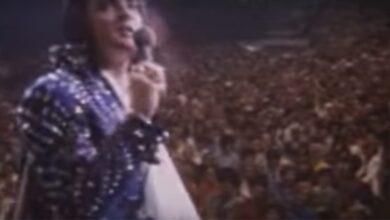Listening To Marty Haggard’s Son Sing His Father’s Song Brings Us To Tears
“Mama’s Hungry Eyes” embodies heartfelt storytelling, a hallmark of country music that draws from the lived experiences of its artists. Merle Haggard penned the song during a time when he was grappling with his own tumultuous background, which included poverty and familial struggles. Born in 1937 in Bakersfield, California, Haggard had a troubled youth, marked by the loss of his father to pneumonia when he was just nine years old. This personal experience fueled his deep appreciation for his mother and the sacrifices she made. Haggard’s lyrical prowess shines through in “Mama’s Hungry Eyes,” where he captures the essence of maternal love shaped by adversity, presenting a narrative that is both intimate and relatable.
The song’s imagery invokes profound emotions and paints a vivid picture of a single mother’s labor-intensive life. Haggard’s mother worked tirelessly, often taking on multiple jobs to ensure that her children had food on their plates and a roof over their heads. The lyrics resonate with the theme of hunger—not merely physical hunger for food but an emotional yearning for support and understanding. Haggard’s ability to convey such themes through simple yet powerful language underscores his mastery as a songwriter. The repeated mention of “hungry eyes” symbolizes a longing for connection, acceptance, and the fleeting nature of youth paired with the steadfast presence of a nurturing figure.
Musically, “Mama’s Hungry Eyes” is characterized by a gentle melody that complements its poignant lyrics. The format of the song, which features a classic country arrangement, allows the listener to focus solely on the emotional weight of the words. Haggard’s authentic vocal style brings a sense of sincerity to the narrative, eliciting a strong emotional response from his audience. The song has become a staple in the country music repertoire, highlighting its timeless nature and continued relevance across generations.
Marty Haggard’s decision to re-record “Mama’s Hungry Eyes” serves as both an homage to his father’s work and a personal interpretation that connects his own experiences growing up in the shadow of Merle’s fame. By introducing new lyrics, such as those detailing their mother’s struggles while working at a truck stop, Marty adds depth and nuance to the original narrative. His version stands as a testament to how stories can evolve through the lens of different generations while retaining their core messages of love and sacrifice.
The emotional resonance of “Mama’s Hungry Eyes” also invites listeners to reflect on their own family dynamics and the relationships they share with their parents. Many individuals find comfort in the song’s depiction of unwavering parental devotion, prompting nostalgia for the complexities of their own childhood experiences. The song becomes a collective memory for those raised with similar struggles, solidifying its place in country music history as an anthem for resilience and familial love.
As both Merle and Marty Haggard navigate their musical careers, the legacy of “Mama’s Hungry Eyes” serves as a binding force, linking their shared experiences and artistic expressions. While Merle’s original rendition serves as a poignant reflection of his past, Marty’s adaptation highlights the ongoing cycle of storytelling within families, echoing themes of strength and affection that transcend time. This connection between father and son underscores the deep roots of country music as a genre built on shared experiences and emotional honesty.
Country music is often characterized by its adherence to authenticity, and “Mama’s Hungry Eyes” exemplifies this principle. Within its verses lies a narrative that speaks broadly to the human condition—illustrating not only the struggles faced by individuals but also the triumphs that come from love and perseverance. The song encourages listeners to appreciate their own family bonds and recognize the sacrifices that often go unseen in the daily grind of life.
Ultimately, the impact of “Mama’s Hungry Eyes” is profound and multifaceted. It serves as a bridge between different generations, allowing contemporary audiences to connect with the struggles and stories of earlier times. This enduring piece of music remains an influential work, grounding itself in the timeless theme of family loyalty while managing to evoke personal reflections in each listener. The song’s legacy, enhanced through the Haggards’ interpretations, stands testament to the power of music as a means of preserving personal and collective histories.
The contributions of Merle and Marty Haggard continue to inspire countless artists within the country music genre and beyond. Their interpretations of “Mama’s Hungry Eyes” remind us that the act of storytelling is vital in connecting humans one to another through shared sentiments and experiences. Even today, new listeners are welcomed into the rich tapestry of country music, where songs like “Mama’s Hungry Eyes” serve as beautiful reminders of the intricate relationships that define our lives. Through the echoes of heartfelt melodies and poignant lyrics, the song remains a cherished treasure, one that resonates deeply with all who have ever loved and sought to provide for their own families.





